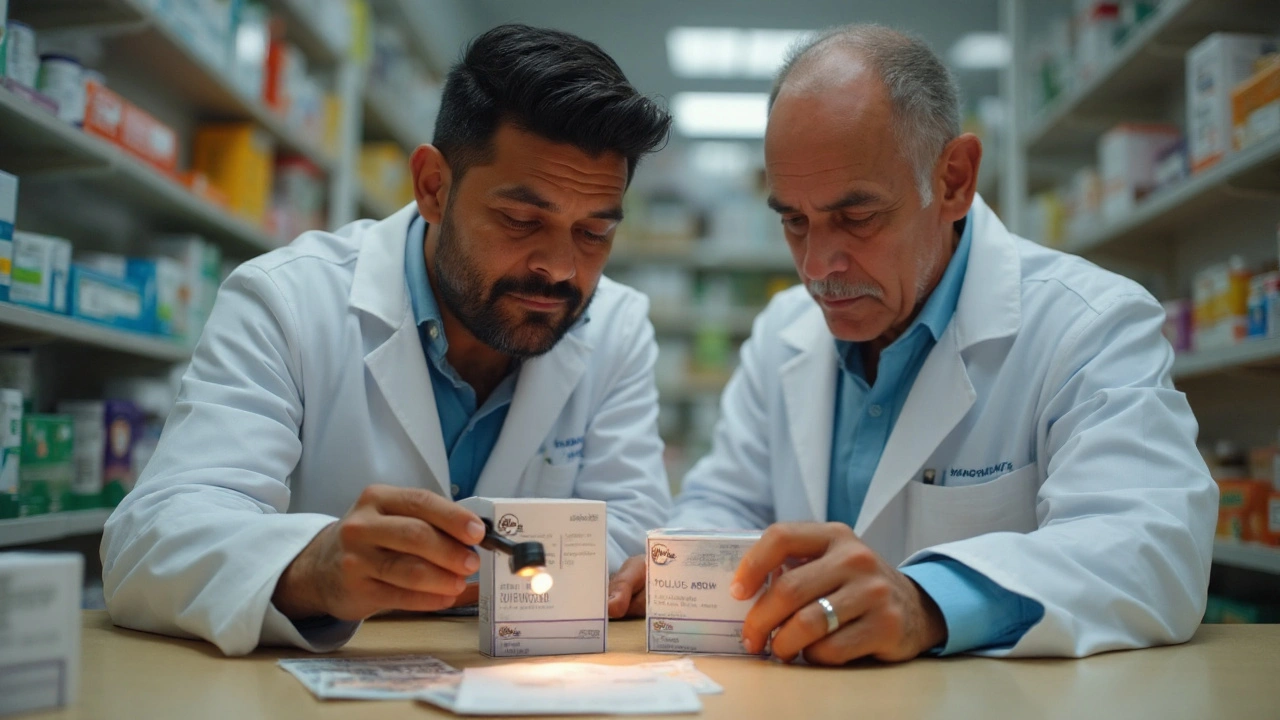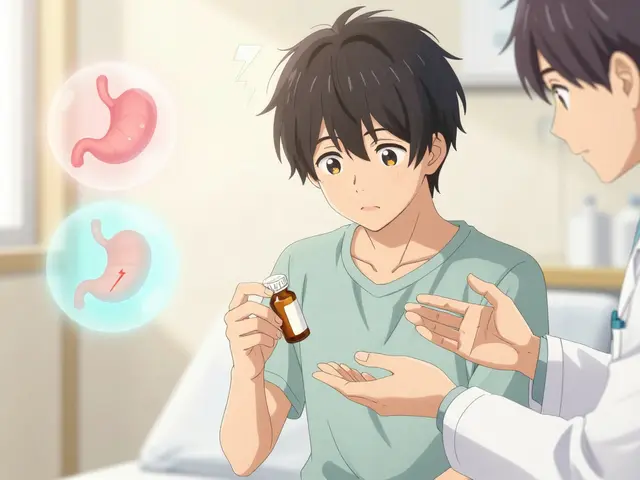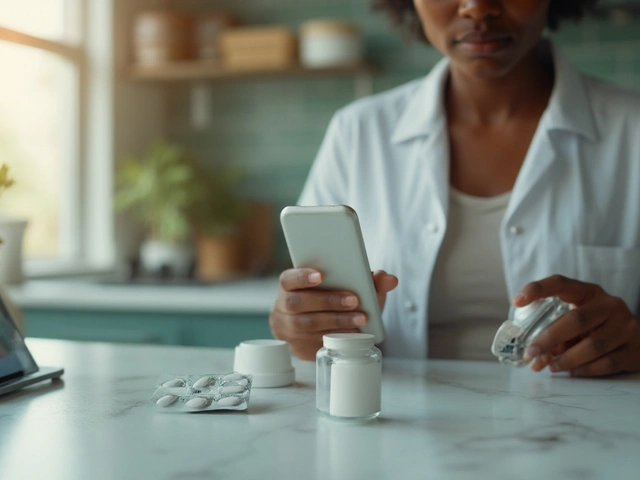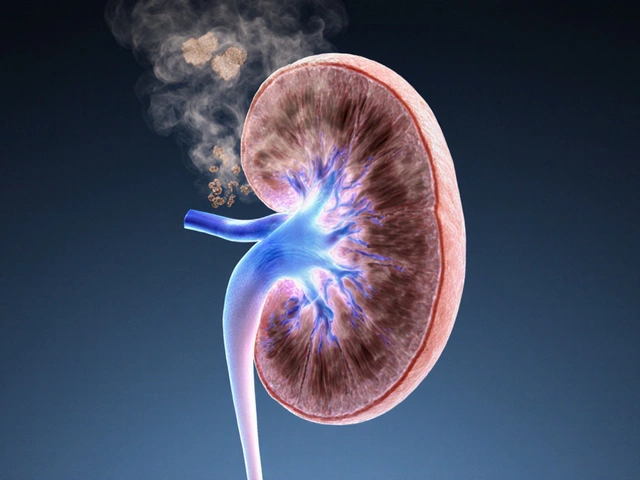You searched a single word and got a mess of results. You want a straight answer: what is Medexil, is it safe, and how do you know you’ve got the right medicine? Here’s the truth. There’s no widely recognized global drug with the exact brand name “Medexil” in major registries as of September 2025. In many cases, people mean “Mexitil,” the brand name for mexiletine, a heart rhythm drug. In other cases, “Medexil” is a local brand in certain countries for a different active ingredient. So the job is to identify what’s actually in your box or prescription, then follow the safety rules that fit that specific drug.
TL;DR
- Medexil is not a standard global name; it’s often a misspelling of Mexitil (mexiletine) or a local brand with a different ingredient. Confirm the active ingredient on your packaging.
- Check the box or leaflet for: active ingredient, strength, manufacturer, lot/expiry, regulator mark (FDA/EMA/local authority), and any 2D barcode/QR serial code.
- If it’s mexiletine (Mexitil), this is a prescription antiarrhythmic-do not self-start or change dose without a cardiologist.
- When unsure, take a photo of the box and ask a pharmacist; cross-check in official sources like the FDA’s Orange Book, EMA’s Medicines database, or your national regulator.
- Watch for side effects, drug interactions, and counterfeit red flags. When in doubt, pause and verify before taking a dose.
What people mean by “Medexil” and how to confirm the exact medicine
Here’s the common mix-up: “Medexil” looks and sounds like “Mexitil.” Mexitil is a brand name for mexiletine, a class IB antiarrhythmic used for certain ventricular arrhythmias. If your bottle says “Mexitil” or “mexiletine,” it’s a heart medicine that needs specialist oversight. But in some regions, “Medexil” is stamped on packaging as a local brand for a completely different ingredient (for example, an antihistamine or an antibiotic). That’s why step one isn’t guessing from the brand-it’s reading the active ingredient on the label.
What to look for on the box or blister:
- Active ingredient (generic name), e.g., mexiletine, cetirizine, amoxicillin-this tells you what the drug actually is.
- Strength, e.g., 200 mg per capsule or 10 mg per tablet.
- Dosage form, e.g., capsule, tablet, oral suspension.
- Manufacturer name and address (at least city/country).
- Lot/batch number and expiration date.
- Regulatory marks: US FDA NDC, EU safety features (unique identifier and anti-tamper), country-specific license numbers (e.g., DCGI in India, TGA in Australia, Health Canada DIN), or a serialization/QR code.
How to confirm authenticity fast in 2025:
- Scan the 2D barcode/QR on the box if present. In the EU (FMD) and many other regions, packs are serialized. Pharmacists can verify decommissioning status; patients can check basic details with official or manufacturer apps.
- Match the active ingredient and strength in official sources: FDA Orange Book (US), EMA Medicines database (EU), your national regulator’s registry, or the WHO’s ATC/DDD Index for classification.
- Ask a licensed pharmacist. Show them the box photo. They can check parallel trade differences, spelling variants, and regional brands quickly.
If your label shows mexiletine, it’s almost certainly the Mexitil situation. If it lists an antihistamine (cetirizine, desloratadine), you’re looking at an allergy med. If it lists an antibiotic (amoxicillin, azithromycin), that’s a prescription antibiotic-do not self-start for colds.
Safe use basics: before you take it, rules that apply to most versions
Until you know the exact active ingredient, hit pause. The same brand-like name can map to very different safety profiles. These rules help you avoid the big mistakes:
- Confirm the active ingredient and strength before the first dose. Brand names travel badly across borders; the generic name is your anchor.
- If it’s a heart rhythm drug (mexiletine), you should already have a cardiology plan. Don’t change dose because you feel “fine” or “worse.” Call your prescriber.
- If it’s an antibiotic, use only when a clinician has confirmed a bacterial infection. Stopping early or using “just in case” drives resistance and relapse.
- If it’s an antihistamine for allergies, check if it’s sedating. Don’t drive or handle machinery until you know how it affects you.
- Pregnant, trying to conceive, or breastfeeding? Verify with a clinician first. Safety varies a lot by drug class.
- Have liver, kidney, or heart disease? Dose and choices change-self-medicating raises risk.
- Keep a simple meds list. Include OTCs, supplements, and recreational substances. Interactions hide in the small stuff, like antihistamines plus alcohol or antibiotics plus antacids.
Red flags-stop and get help:
- New chest pain, severe palpitations, fainting.
- Swelling of face or throat, trouble breathing (possible severe allergy).
- Peeling rash, blisters, high fever with sore throat (possible severe skin reaction).
- Yellow eyes/skin, dark urine, severe abdominal pain (possible liver issue).
Sources worth trusting when safety is on the line: your prescribing clinician; a licensed pharmacist; official monographs from regulators (FDA, EMA, MHRA, Health Canada); and national formularies. These are primary sources used by professionals.

Side effects and interactions: what to watch for right away
Side effects depend on the exact drug, but you can use this pattern to spot trouble early:
- Early-onset side effects tend to show up within the first few doses: dizziness, nausea, drowsiness, rashes.
- Interaction signals often look like “too much” of something: extreme drowsiness (sedating antihistamine + alcohol), dangerous heart rhythms (mexiletine + other QT/arrhythmia drugs), bleeding (NSAID + blood thinners).
- Delayed effects might appear after days to weeks: gut changes on antibiotics, liver enzyme elevations on certain meds, mood or sleep changes.
Use the table below as a quick orientation tool. Match what your label says under “Active ingredient” to get the general risk vibe and whether you can self-start. This is not a replacement for local guidance, but it’s a helpful map.
| Active ingredient on your label | Drug class | Typical reason used | OK to self-start? | Watch-outs |
|---|---|---|---|---|
| Mexiletine | Antiarrhythmic (Class IB) | Serious ventricular arrhythmias | No - specialist only | Arrhythmias, dizziness, tremor; interactions with other heart drugs |
| Cetirizine / Desloratadine | Antihistamine | Allergies, hives | Yes (OTC in many regions) | Drowsiness (less with desloratadine), dry mouth; alcohol adds sedation |
| Ibuprofen / Naproxen | NSAID | Pain, inflammation | Yes (OTC doses) | Stomach irritation/bleeding, kidney strain; avoid with blood thinners |
| Amoxicillin / Azithromycin | Antibiotic | Bacterial infections | No - prescription | Diarrhea, rash; resistance if misused; interactions with antacids (azithro timing) |
| Omeprazole | PPI | Reflux, ulcers | Short self-trials OK | Low magnesium with long use; interacts with clopidogrel (check with prescriber) |
| Metformin | Biguanide | Type 2 diabetes | No - clinician-managed | GI upset; rare lactic acidosis; adjust in kidney disease |
Interaction traps people miss:
- Multiple meds that slow you down (antihistamines, sleep aids, alcohol): adds up to dangerous sedation.
- Heart rhythm interactions: if you see mexiletine on your label, your prescriber checks ECGs for a reason. Ask before adding any new drug, even OTC.
- Stomach meds vs absorption: PPIs/antacids can change how some antibiotics and heart meds absorb.
- Herbal products: St. John’s wort, for example, can change how your liver handles many prescriptions.
Where this guidance comes from: regulator monographs (FDA Drug Labels, EMA Product Information), national formularies, and standard clinical references used by pharmacists and clinicians.
Practical steps: verify, dose, store, and handle problems
Think of this as your action checklist-the stuff that actually prevents mistakes.
- Identify your exact drug
- Read the active ingredient, strength, and manufacturer on the pack or leaflet.
- Check the lot number and expiry. If the ink is smeared or the dates look off, pause and verify.
- Scan the 2D barcode/QR if present. Serialization is now standard in the EU and many markets, and US DSCSA interoperability rules are active. Pharmacists can confirm status.
- Confirm with a trusted source
- Ask a pharmacist: “Is this mexiletine? Or an antihistamine? Can you check it in the database?”
- Cross-check in an official registry: FDA Orange Book (US), EMA Medicines, national regulator databases, or the WHO ATC Index.
- Follow dosing the smart way
- For specialist drugs (like mexiletine), follow your cardiologist’s plan to the letter. Don’t copy someone else’s dose.
- For OTC antihistamines, use the leaflet dosing by age/weight. If you are sensitive to sedation, start when you’re not driving.
- For antibiotics, don’t start without a prescription. If prescribed, finish the course unless your clinician says to stop.
- Store it right
- Room temp unless the label says otherwise (often 20-25°C / 68-77°F), dry place, away from sunlight.
- Keep out of reach of kids and pets; original container helps you avoid mix-ups.
- Handle a missed dose correctly
- If you remember soon, take it. If you’re near the next dose, skip the missed one. Don’t double up-especially on heart meds.
- Spot counterfeits
- Broken seals, inconsistent fonts, spelling errors, or pills that look different than usual.
- QR/serial code that doesn’t scan or verify.
- Price that’s suspiciously low from an unverified seller.
- Know when to call for help
- New chest symptoms, fainting, severe rash, breathing trouble: seek urgent care.
- Unexpected side effects or no improvement: contact your prescriber or pharmacist.
Pro tips that save headaches:
- Take a clear photo of your box, the blister, and the leaflet. Send it to your pharmacist before you go in-they’ll be ready with answers.
- Write down why it was prescribed and the target symptom. If it’s not improving that target, it’s feedback your clinician needs.
- Keep a one-page meds list (name, dose, time of day, reason). Hand it over at every appointment.

FAQ, costs, and next steps in 2025
Is “Medexil” the same as “Mexitil” (mexiletine)?
Often that’s the case in search queries, yes. But never assume. Check your label for “mexiletine.” If present, treat it as a specialist heart drug and call your cardiology team for any dosing questions.
Is mexiletine safe?
It’s effective for the right patient and rhythm problem, but it’s not a casual medication. Heart rhythm drugs can trigger other rhythm issues if used wrong. That’s why dosing and monitoring are individualized by a cardiologist, often with ECG checks.
Can I drink alcohol with this?
Depends on the drug you actually have. Antihistamines and many pain meds add sedation with alcohol. For mexiletine, alcohol can worsen dizziness or tremor. When unsure, avoid alcohol until your pharmacist clears it.
What if my box actually says an antihistamine?
Then you likely have an allergy medicine. For non-drowsy options (like desloratadine), daytime use is usually fine. For older or sedating antihistamines, test it on a low-stakes evening before driving.
What if it’s an antibiotic?
Use only if prescribed for a confirmed bacterial infection. Take it exactly as directed, and finish the course. If you develop severe diarrhea or rash, call your clinician.
How do I check if my pack is legit?
Look for the regulator’s license numbers, intact tamper-evident seal, and a scannable 2D barcode/QR with serial. Compare pill shape/color with the leaflet image. When in doubt, bring it to a pharmacy for verification.
How much should it cost?
Costs vary by country, supply chain, and whether you’re buying a brand or generic. In many markets, generics are substantially cheaper. A pharmacist can quote local prices and suggest safe generics.
Can I switch brands?
For many drugs, brand-to-generic switches are fine if the active ingredient and strength match. For narrow-therapeutic-index drugs or heart rhythm meds, ask your prescriber first. Consistency can matter.
What if I took a dose but now I’m unsure what it was?
If no symptoms: call a pharmacist, read the box together, and confirm the ingredient. If concerning symptoms appear-severe dizziness, chest pain, facial swelling-seek urgent care and bring the packaging.
Next steps if you’re still unsure:
- Photograph the box, blister, and leaflet.
- Call or visit a pharmacy with those photos. Ask them to identify the active ingredient and verify the pack.
- If it is mexiletine, contact your cardiology clinic for confirmation of dose and schedule.
- If it’s something else, ask for the official patient leaflet or regulator monograph matching your exact product.
Troubleshooting by situation:
- You can’t find the active ingredient on the box: check the leaflet inside; sometimes the front is brand-only. If nothing, do not take it-bring it to a pharmacy.
- The QR/serial isn’t scanning: try a different app or lighting. Some codes are distributor-only; a pharmacist can scan on their system.
- The pills look different than last time: pharmacies sometimes switch manufacturers. Verify the new imprint code and shape with your pharmacist before taking any.
- You lost the leaflet: many regulators host Patient Information Leaflets. Ask the pharmacist to print or read the main points to you.
Where professionals check facts:
- Regulatory monographs and labels from the US FDA, European Medicines Agency (EMA), UK MHRA, Health Canada, TGA (Australia), and your national authority.
- Official formularies and guidelines such as the British National Formulary (BNF) and therapeutic guidelines for specific conditions.
- WHO classifications (ATC/DDD) for drug classes and typical dosing contexts.
Bottom line: don’t let a look-alike brand name push you into a bad decision. Confirm the active ingredient, verify the pack, and match your next move to the actual medicine in your hand. One careful check beats days of worry.








Shawna B
September 19, 2025 AT 12:47Sophia Lyateva
September 19, 2025 AT 15:12AARON HERNANDEZ ZAVALA
September 21, 2025 AT 05:06also thanks for the checklist. i printed it out.
Lyn James
September 22, 2025 AT 18:07Craig Ballantyne
September 23, 2025 AT 12:03Nicholas Swiontek
September 24, 2025 AT 18:22Robert Asel
September 26, 2025 AT 07:43Shannon Wright
September 27, 2025 AT 05:48